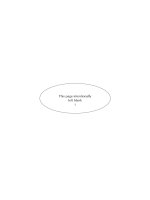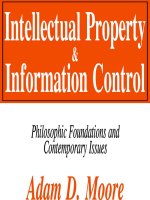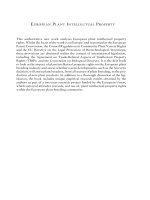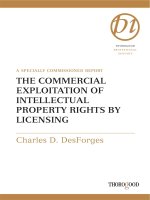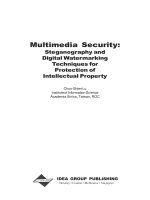INTELLECTUAL PROPERTY pptx
Bạn đang xem bản rút gọn của tài liệu. Xem và tải ngay bản đầy đủ của tài liệu tại đây (8.58 MB, 890 trang )
I
NTELLECTUAL
P
ROPERTY
V
ALUATION
, E
XPLOITATION
,
AND
I
NFRINGEMENT
D
AMAGES
G
ORDON
V. S
MITH
R
USSELL
L. P
ARR
JOHN WILEY & SONS, INC.
I
NTELLECTUAL
P
ROPERTY
I
NTELLECTUAL
P
ROPERTY
V
ALUATION
, E
XPLOITATION
,
AND
I
NFRINGEMENT
D
AMAGES
G
ORDON
V. S
MITH
R
USSELL
L. P
ARR
JOHN WILEY & SONS, INC.
This book is printed on acid-free paper.
Copyright © 2005 by John Wiley & Sons, Inc. All rights reserved.
Published by John Wiley & Sons, Inc., Hoboken, New Jersey.
Published simultaneously in Canada.
No part of this publication may be reproduced, stored in a retrieval system, or transmitted in any form or by any
means, electronic, mechanical, photocopying, recording, scanning, or otherwise, except as permitted under
Section 107 or 108 of the 1976 United States Copyright Act, without either the prior written permission of the
Publisher, or authorization through payment of the appropriate per-copy fee to the Copyright Clearance Center,
Inc., 222 Rosewood Drive, Danvers, MA 01923, 978-750-8400, fax 978-646-8600, or on the web at
www.copyright.com. Requests to the Publisher for permission should be addressed to the Permissions
Department, John Wiley & Sons, Inc., 111 River Street, Hoboken, NJ 07030, 201-748-6011, fax 201-748-6008,
and online at />Limit of Liability/Disclaimer of Warranty: While the publisher and author have used their best efforts in
preparing this book, they make no representations or warranties with respect to the accuracy or completeness of
the contents of this book and specifically disclaim any implied warranties of merchantability or fitness for a
particular purpose. No warranty may be created or extended by sales representatives or written sales materials.
The advice and strategies contained herein may not be suitable for your situation. You should consult with a
professional where appropriate. Neither the publisher nor author shall be liable for any loss of profit or any other
commercial damages, including but not limited to special, incidental, consequential, or other damages.
For general information on our other products and services, or technical support, please contact our Customer
Care Department within the United States at 800-762-2974, outside the United States at 317-572-3993 or fax
317-572-4002.
Wiley also publishes its books in a variety of electronic formats. Some content that appears in print may not be
available in electronic books.
For more information about Wiley products, visit our web site at www.wiley.com.
Library of Congress Cataloging-in-Publication Data:
ISBN-13 978-0-471-68323-X
ISBN-10 0-471-68323-X
Printed in the United States of America
10987654321
Russell Parr would like to thank his mother Dorothy Parr. She gave me the
most valuable intangibles in the world, and I have subsequently attained
great professional and personal success because of her. Thank you, Mom.
For Nancy Bunker Smith, my wife and partner of nearly five decades, and
for the wonderful family we enjoy so much, Craig and Susan, Tracy and Lee,
Sam, Carlye, Molly, and Jamie.
BECOME A SUBSCRIBER!
Did you purchase this product from a bookstore?
If you did, it’s important for you to become a subscriber. John Wiley & Sons, Inc. may publish, on
a periodic basis, supplements and new editions to reflect the latest changes in the subject matter
that you need to know in order to stay competitive in this ever-changing industry. By contacting
the Wiley office nearest you, you’ll receive any current update at no additional charge. In addition,
you’ll receive future updates and revised or related volumes on a 30-day examination review.
If you purchased this product directly from John Wiley & Sons, Inc., we have already recorded
your subscription for this update service.
To become a subscriber, please call 1-877-762-2974 or send your name, company name (if
applicable), address, and the title of the product to:
mailing address: Supplement Department
John Wiley & Sons, Inc.
One Wiley Drive
Somerset, NJ 08875
e-mail:
fax: 1-732-302-2300
online: www.wiley.com
For customers outside the United States, please contact the Wiley office nearest you:
Professional & Reference Division
John Wiley & Sons Canada, Ltd.
22 Worcester Road
Etobicoke, Ontario M9W 1L1
CANADA
Phone: 416-236-4433
Phone: 1-800-567-4797
Fax: 416-236-4447
Email:
John Wiley & Sons, Ltd.
The Atrium
Southern Gate, Chichester
West Sussex PO 19 8SQ
ENGLAND
Phone: 44-1243-779777
Fax: 44-1243-775878
Email:
John Wiley & Sons Australia, Ltd.
33 Park Road
P.O. Box 1226
Milton, Queensland 4064
AUSTRALIA
Phone: 61-7-3859-9755
Fax: 61-7-3859-9715
Email:
John Wiley & Sons (Asia) Pte., Ltd.
2 Clementi Loop #02-01
SINGAPORE 129809
Phone: 65-64632400
Fax: 65-64634604/5/6
Customer Service: 65-64604280
Email:
Update
Service
vii
ABOUT THE AUTHORS
Gordon V. Smith is chairman of AUS, Inc. and president of AUS Consultants. He has advised
clients in valuation matters for over 40 years. His assignments have included appraisals of
nearly every type of tangible and intangible property as well as consultations relative to royalty
rates, economic life, and litigation damages for intellectual property. Clients have been many of
the Fortune 500 and major international law firms, as well as research and educational institu-
tions, regulatory bodies, and the U.S. government.
Mr. Smith, a graduate of Harvard University, has lectured on valuation subjects throughout
the Americas, in Europe, and extensively in Asia. He has taught university-level courses at Sin-
gapore Management University and conducted seminars for the IP Academy (Singapore), the
Chinese government, the U.S. Treasury Department, numerous private organizations and corpo-
rations, and has lectured in various countries for the World Intellectual Property Organization.
He is a member of the Advisory Committee on Intellectual Property and Board of Trustees
of Pierce Law, whose intellectual property curriculum is nationally recognized. He is also an
adjunct professor there and a regular guest lecturer. An active member of the International
Trademark Association, Mr. Smith is also a member of the Licensing Executives Society. His
writings include many professional papers and articles that have appeared in publications here
and abroad.
He has authored four books, published by John Wiley & Sons, Inc., titled: Corporate Valua-
tion: A Business and Professional Guide; Trademark Valuation; Valuation of Intellectual Prop-
erty and Intangible Assets (coauthor); Intellectual Property: Licensing and Joint Venture Profit
Strategies (coauthor), and has contributed to several other Wiley intellectual property and tax
reference books.
Russell L. Parr, CFA, ASA, is president of IPRA, Inc.—Intellectual Property Research Asso-
ciates (www.ipresearch.com). He is an expert in determining the value of intellectual property.
Mr. Parr’s books about intellectual property value and management are published in Japanese,
Korean, Italian, and English. He is dedicated to the development of comprehensive methods for
accurately defining the value of intellectual property.
Highlight assignments conducted by Mr. Parr have included the valuation of the Dr. Seuss
copyrights and the patent portfolio of AT&T. Mr. Parr also has conducted valuations and roy-
alty rate studies for communications technology, pharmaceuticals, semiconductor process and
product technology, automotive battery technology, lasers, agricultural formulations, biotech-
nology, computer software, drug delivery systems, medical products technology, incinerator
feed systems, camera technology, flowers, consumer and corporate trademarks, motivational
book copyrights, and cosmetics. His opinions are used to accomplish licensing transactions,
acquisitions, transfer pricing, litigation support, collateral-based financing, and joint ventures.
Mr. Parr has written 24 articles that have been published in various professional journals. He
has spoken at over 30 conferences regarding the value of technology, including those sponsored
by the World Intellectual Property Organization in Singapore and Lima, Peru. He also has testi-
fied about the value of companies and intellectual property over 40 times at deposition, trial, or
for arbitration.
Mr. Parr has a master’s in business administration from Rutgers University (1981); a bache-
lor of science in electrical engineering, from Rutgers University (1976); coursework toward
Ph.D. in the International Business Management Program at Rutgers University. His profes-
sional designations include Chartered Financial Analyst (CFA) from the Association for Invest-
ment Management and Research and Accredited Senior Appraiser (ASA) of the American
Society of Appraisers.
viii About the Authors
Among Mr. Parr’s writings are five books published by John Wiley & Sons and three books
published by IPRA, Inc.
His Wiley books include: Valuation of Intellectual Property & Intangible Assets, third edi-
tion: Intellectual Property: Joint Venture and Profit Strategies, second edition; Intellectual
Property Infringement Damages: A Litigation Support Handbook, second edition; Investing in
Intangible Assets; and Corporate Strategies for Maximizing Value.
His books published by IPRA, Inc. include: Royalty Rates for Pharmaceuticals and Biotech-
nology, fifth edition; Royalty Rates for Technology, third edition; and Royalty Rates for Trade-
marks and Copyrights, second edition.
ix
ACKNOWLEDGMENTS
We continue to learn about the world of intellectual property from our clients, colleagues, and
students and wish to recognize those who have come forth to contribute to this book.
Anna L. Johns, Esq. is a senior associate with the prestigious law firm of Dewey Ballantine.
She is a lawyer and accountant. Her intellect and tenacity reduces mountains of information into
clarity. Trade secret damages are complex, and she brings her skills to bear in a chapter at the end
of this book that greatly contributes to damages calculations.
Robert Goldscheider, John Jaroz, and Carla Mulhern have grappled with the complex con-
troversies of the 25% Rule. Their work on this topic has left the entire licensing industry in a much
better position. We are very pleased to include their exhaustive study in this book.
Patrick H. Sullivan, Sr. is founder of ICM Group. He is dedicated to the maximum extraction
of value from all forms of intellectual property and intangible assets. He is rightly dedicated to
bringing these assets to the forefront of executive management mindsets. His abstract thinking can
cause headaches but always leaves you better off.
Kathleen M. Kerowski of Ernst & Young and Maria S. Lehman of Davis & Hosfield Con-
sulting, LLC, have contributed greatly to the understanding of trademark damages.
Charles E. Jerominski of AUS Consultants continues to lend his expertise in the area of statis-
tical lifing techniques. David G. Weiler, managing director of RoyaltySource has provided sup-
port in our research, as have Jerome Weinert, Michael Diedrich, and Mary Beth McAndrews of
AUS Consultants.
Drs. Richard A. Michelfelder and Maureen Morrin are professors at Rutgers University who
have greatly assisted us with their research on forecasting models applicable to intellectual prop-
erty exploitations.
Dr. John A. Del Roccili of Econsult Corporation in Philadelphia always brings sharp insight
into our discussions, and we appreciate his appendix contribution.
xi
Because of the rapidly changing nature of information in this field, this product may be updated
with annual supplements or with future editions. Please call 1-877-762-2974 or email us at
to receive any current update at no additional charge. We will send on approval
any future supplements or new editions when they become available. If you purchased this product
directly from John Wiley & Sons, Inc., we have already recorded your subscription for this update
service.
CONTENTS
Preface xxiii
P
ART
IV
ALUATION
1
1 Intellectual Property and Intangible Assets
in the World Today 3
1.1 Some History 3
1.2 Legislation Created Intellectual Property 5
1.3 Need for Intellectual Property Valuations 6
1.4 Intellectual Property Exploitation 8
1.5 Legal Attitudes Enhance Value 10
1.6 When Intellectual Properties Collide 11
2 Defining Intangible Assets and Intellectual Property 13
2.1 Intangible Assets 13
2.2 Intellectual Property 21
3 Defining Intangible Assets and Intellectual
Property—Trademarks 36
3.1 Trademarks 36
3.2 Trademark Defined 37
3.3 Trademarks—The Legal Underpinnings 43
3.4 Trademark Creation 46
3.5 Naming Rights 61
4 Intangible Assets and the Business Enterprise 66
4.1 The Business Enterprise 66
4.2 Summary 79
xii Contents
5 Accounting Issues 81
5.1 Introduction 81
5.2 Accounting Principles Relating to Valuation 83
5.3 New Developments in Accounting for Intangible Assets 95
5.4 Cost and Value 109
Appendices
5A Intangible Asset List—Exposure Draft 112
5B Intangible Asset List—Final SFAS No. 141 114
5C Relevant Documents in the Development
of SFAS No. 141 and SFAS No. 142 116
6 Tax Issues 117
6.1 Tax Considerations 117
6.2 Primary Standards 122
6.3 Property Definitions 125
6.4 Methods for Determining Intangible Asset Transfer Prices 126
6.5 Cost-Sharing Arrangements 132
6.6 Investment Holding Companies 136
7 Valuation Principles and Techniques 140
7.1 Valuation Principles 140
7.2 Valuation Methods 148
7.3 Summary 155
8 Cost Approach 156
8.1 General Cost Approach Principles 156
8.2 Cautions in Using the Cost Approach for Intellectual Property 165
8.3 Using the Cost Approach for Trademarks 166
8.4 Using the Cost Approach for Technology 168
8.5 Cost Approach—Summary 168
9 Market Approach 169
9.1 Market Transactions of Intellectual Property Indicate Value 169
9.2 Market Events Can Indicate Value 171
9.3 A Lost Patent Indicates Value 171
9.4 Analyzing the Business Enterprise to Indicate Value 175
9.5 Market Approach—Summary 183
10 Income Approach—Quantifying the Economic Benefit 185
10.1 Market Value Equals the Present Value of the Future
Economic Benefits of Ownership 185
10.2 Quantifying the Economic Benefit 185
Contents xiii
11 Income Approach—Timing and Pattern of Receiving
the Economic Benefit 212
11.1 Market Value Equals the Present Value of the Future
Economic Benefits of Ownership 212
11.2 Economic Life Defined 212
11.3 Economic Life of Intangible Assets and Intellectual Property 219
12 Income Approach—Evaluating the Risk of Receiving
the Economic Benefit and Putting It All Together 241
12.1 Market Value Equals the Present Value of the Future
Economic Benefits of Ownership 241
12.2 Income Approach—Putting It All Together 245
13 When Theory Meets Practice 252
13.1 Valuation Challenges 252
13.2 Common Valuation Errors 255
13.3 Valuation Method Preferences 259
14 Special Valuation Situations 270
14.1 Intangibles in Bankruptcy and as Collateral 270
14.2 Ad Valorem Taxes 277
14.3 Intangible Assets in Regulated Industries 277
15 Early-Stage Technology Valuation 285
15.1 Early-Stage Technology 285
15.2 Cost Approach and Early-Stage Technology 286
15.3 Market Approach and Early-Stage Technology 286
15.4 Income Approach and Early-Stage Technology 289
15.5 Summary 296
16 International Issues 301
16.1 International Valuation Standards 302
16.2 Other International Valuation Issues 305
16.3 Summary 309
P
ART
II L
ICENSING
311
17 Emergence of Intellectual Property Exploitation
Strategies 313
17.1 Factors Driving Strategic Alliances: Time, Cost, and Risk 314
17.2 A Short History of Corporate Strategies 316
17.3 Legal Attitudes Enhance Value 320
xiv Contents
18 Introduction to Exploitation Strategies 321
18.1 Some History 321
18.2 Enter Technological Change 321
18.3 Business Enterprise Model 323
18.4 Economics of Exploitation 325
18.5 Development of Intellectual Property 326
18.6 Source of Production Factors 328
18.7 Internal Strategies 329
18.8 The Entrepreneurial Corporation 330
18.9 Acquisition 331
18.10 External Strategies 332
18.11 Ownership Alliances 338
18.12 Other Liquidity Concerns 339
18.13 Establishing a Cross-ownership Alliance 341
18.14 Strategic Alliances—Rapid Technological Change 342
18.15 Creating Industry Standards 345
19 Economic Contributions of Intellectual Property 352
19.1 Intellectual Property Contributes Powerfully to Earnings 352
19.2 Intellectual Property Sustains Superior Earnings 352
19.3 Enhanced Profits and Intellectual Property 353
19.4 Investment Rate of Return Analysis 359
19.5 Discounted Cash Flow Analysis 364
19.6 Comparable License Transactions 367
19.7 Simplistic Rules of Thumb 374
20 Global Exploitation Potential 376
20.1 Impact of the International Environment 376
20.2 Accounting Issues 377
20.3 Taxes 379
20.4 Transfer Pricing 380
20.5 Methods for Determining Intangible Asset Transfer Prices 385
20.6 Political Risk 387
20.7 New Markets 388
20.8 Repatriation 389
20.9 Cultural Issues 391
20.10 investment Risk 391
20.11 Legal Protection 393
20.12 Summary 394
21 Risks of Exploitation 395
21.1 Elements of Risk 395
21.2 Risk and Royalties 401
Contents xv
21.3 Intellectual Property Economic Life 405
21.4 Summary 409
22 Use of the 25% Rule in Valuing Intellectual Property 410
22.1 Introduction 410
22.2 History of the Rule 411
22.3 Explanation of the Rule 412
22.4 Illustration of the Rule 414
22.5 Application of the Rule 416
22.6 Justification for the Rule 418
22.7 Criticisms of the Rule 419
22.8 Empirical Test of the Rule 421
22.9 Conclusions 426
23 Licensing Economics and Royalty Rates 427
23.1 Pricing the Alternatives 429
23.2 Licensing 435
23.3 Primary Economic Drivers 436
23.4 Secondary Economic Drivers 453
23.5 Evaluating the Net Present Value 457
23.6 Summary 457
24 Determining a Royalty Rate—An Example 460
24.1 Description of the Patented DermaPulse Invention 460
24.2 Financial Review 461
24.3 Intellectual Property Economic Contribution 461
24.4 Analysis of Specific Market Transactions 471
24.5 Conclusion 476
25 Dealing with Early-Stage Intellectual Property 477
25.1 Early-Stage Technology 479
25.2 Development Costs 480
25.3 Risk 483
25.4 Time 484
25.5 The DCF Mechanism 484
25.6 Using Discounted Cash Flow (DCF) as a Measuring Tool 485
26 Trademark Licensing 494
26.1 Trademark Royalties 494
26.2 Royalty Quantification 501
27 Licensing Negotiations and Agreements 518
27.1 Licensing Negotiations 518
27.2 Licensing Agreements 523
xvi Contents
27.3 Critical Questions 526
27.4 Licensing-In Technology 526
27.5 Licensing-Out Technology 530
27.6 Conclusion 535
28 Licensing Internet Assets 536
28.1 Internet Background 537
28.2 Internet Economics 537
28.3 Internet Licensing 543
29 Another View of Licensing Strategies 548
29.1 Defensive Strategies 548
29.2 Cost Centers 549
29.3 Profit Centers 550
29.4 Integrated Management 552
29.5 Visionary Intellectual Property Management 553
29.6 Making the Big Bucks 553
29.7 Intellectual Property Touches all Aspects of Life 554
29.8 Intangible Assets at the Center of Deals 556
29.9 E-Commerce and Intellectual Property 556
29.10 Specific Trends in Intellectual Property Deal Making 557
29.11 Trademark Strategies 561
29.12 Intangible Riches 563
30 Joint Venture 564
30.1 Ownership Split 566
30.2 Expansion at Overboard Industries, Inc. 566
30.3 Consumer Electronics 567
30.4 Access to the Technology 568
30.5 Access to the Market 569
30.6 Measuring Potential Value from Pin-Point 569
30.7 Weighted Average Cost of Capital 572
30.8 Internal Technology Development 573
30.9 Internal Trademark Development 574
30.10 Going it Alone 577
30.11 Summary 577
30.12 Special Problems with Strategic Alliances 580
31 University Technology Transfer 583
31.1 University Technology Transfer Goals 584
31.2 University Offices of Technology Transfer 585
31.3 Conflicts of Interest 586
31.4 Nonexclusive Licenses 586
31.5 Finding Technology 587
Contents xvii
31.6 Rewards of Inventorship 588
31.7 Harvard University—Royalty-Sharing Policy
for Intellectual Property 588
31.8 Johns Hopkins University—Sharing of Revenue
from Intellectual Property 590
31.9 Dealing with Universities 591
32 Organizing for the Future 592
32.1 Mapping Intellectual Property 592
32.2 Identification 593
32.3 Assembled Workforce 595
32.4 Captive Spare Parts Annuity 596
32.5 Computer Software 596
32.6 Copyrights 597
32.7 Customer Lists 597
32.8 Distribution Networks 597
32.9 Trademarks 597
32.10 Strategic Plan and Gap Analysis 597
33 Monitoring License Agreements 605
33.1 Introduction 605
33.2 Overview of Licensing 605
33.3 Licensing Business Risks 607
33.4 License Management 609
33.5 Auditing the Royalty Obligations 610
33.6 Common Audit Procedures and Findings 612
33.7 Remedies from Breaches of Licensing Contracts 613
33.8 Conclusion 614
P
ART
III I
NFRINGEMENT
D
AMAGES
615
34 Lost-Profit Calculations 617
34.1 Definition of Lost-Profit Damages 617
34.2 Patent Infringement 617
34.3 Trademark Infringement 618
34.4 Copyright Infringement 618
34.5 Lost Profits 619
34.6 The Panduit Test for Calculating Lost Profit 622
34.7 Calculating Lost Profit After Panduit 626
34.8 Incremental Profits 630
34.9 Profit and Loss Statements 633
34.10 Fixed and Variable Costs 635
34.11 An Example of Incremental Profits 640
xviii Contents
34.12 Fixed Costs Aren’t Always Fixed 646
34.13 Summary 646
35 Royalty Rates and the Georgia-Pacific Factors 648
35.1 Factors for Deriving a Responsible Royalty 648
35.2 Summary 654
36 The Analytical Approach 655
36.1 Normal Industry Profits 656
36.2 A More Comprehensive Analytical Approach 657
36.3 Hypothetical Example 658
36.4 Generic Drug Pricing 659
36.5 Summary 660
37 Discounted Cash Flow Analysis 661
37.1 PharmaProd Commodity Corp. Value 663
37.2 New PharmaProd Corp. Royalty Rate 666
37.3 Lost Value 666
37.4 Summary 668
38 Market-Derived Royalty Rates 669
38.1 Internal Licenses Are Often Self-Serving 669
38.2 Relevant Time Period 670
38.3 Financial Condition of Both Licensing Parties 670
38.4 Relevant Industry Transactions 671
38.5 Governmental Regulations 672
38.6 Are the Independent Parties Really Independent? 673
38.7 Outcome of an Infringement Lawsuit 673
38.8 Summary 674
39 Trademark Damages 675
39.1 Counterfeiting 676
39.2 The Law Relating to Monetary Relief 677
39.3 Confusion 685
39.4 Case Analysis 686
39.5 Conclusion 694
40 Estimating Damages for Infringement of Agricultural
Biotechnology-Derived Products 697
40.1 Introduction 697
40.2 What Is Agricultural Biotechnology? 697
40.3 Determining Benefits: The Case of Bt Corn 700
40.4 Conventional Methods of ECB Control 701
Contents xix
40.5 The Economics of ECB Control 702
40.6 Value of Bt 704
41 A Review of Court-Awarded Royalty Rates
in Patent Infringement Cases (1990–2001) 706
41.1 Introduction 706
41.2 Royalties as a Measure of Damages 706
41.3 Royalty Rate Awards Categorized by Industry 709
41.4 Basis for Royalty Rates 709
41.5 The Hypothetical Negotiation 712
41.6 Consideration of the Georgia-Pacific Factors 713
41.7 Federal Circuit Decisions on Royalty Awards 715
41.8 Other Considerations in the Determination of
a Reasonable Royalty 719
41.9 Conclusion 722
42 Trademark Damage Trends in the Federal Circuit
(1982–2001) 723
42.1 Introduction 723
42.2 Overview of Trademarks 724
42.3 Injunctive and Monetary Relief Guidance 725
42.4 Trends in Trademark Damages Awards 726
42.5 Conclusion 731
43 Recent Decision: Copyright Infringement Damages
Can Be Based on Value of Licenses 732
43.1 Introduction 732
43.2 On Davis v. The Gap, Inc.732
43.3 Conclusion 743
44 Trade Secret Damages 747
44.1 Summary of Trade Secret Damages 747
44.2 Royalty Method of Calculating Damages for Misappropriation
of Trade Secret 748
44.3 Plaintiff’s Lost Profits Method of Calculating Damages
for Misappropriation of Trade Secret 749
44.4 Defendant’s Profit Method of Calculating Damages
for Misappropriation of Trade Secret 749
44.5 Other Methods of Calculating Damages for Misappropriation
of Trade Secret 750
44.6 The Accounting Period for Trade Secret Misappropriation
Damages 752
xx Contents
P
ART
IV A
PPENDICES
755
A Investment Rate of Return 757
A.1 Investment Rate of Return 757
A.2 Required Rate of Return Components 758
A.3 Rate of Return Models 759
A.4 Weighted Average Cost of Capital 764
A.5 Appropriate Return on Monetary Assets 765
A.6 Appropriate Return on Tangible Assets 765
A.7 Appropriate Return on Intangible Assets and Intellectual
Property 766
A.8 Prejudgment Interest Rates 767
A.9 References 768
B Theoretical Foundations for the Determination of a Fair
Rate of Return on Intellectual Property 769
C The Use and Abuse of Iowa Curves When Quantifying
Appraisal Depreciation 771
C.1 Appraisal Depreciation 771
C.2 Iowa-Type Survivor Curve 772
C.3 Appraisal Depreciation and Iowa Curves 780
C.4 Valuation Theory of Condition Percent 780
C.5 Iowa Curve Misapplication and Underlying Fallacious
Assumptions 781
C.6 Effects of Misapplication of Iowa Curves on Appraisal Results 783
D Financial and Business Information Sources 785
D.1 A Starting Point 785
D.2 Financial Data 785
D.3 CD-ROM Databases 788
D.4 Economic Data 789
D.5 International Data 789
D.6 Sources of Sources 789
D.7 Royalty Rate Information 791
D.8 Publications 793
E Sample Royalty Rate Information 797
E.1 Technology Royalty Rates 797
E.2 Trademark Royalty Rates 804
E.3 Pharmaceuticals & Biotechnology Royalty Rates 808
Contents xxi
F Overview of New Product Diffusion Sales
Forecasting Models 817
F.1 Introduction 817
F.2 New Product Sales Forecasting Models: Product Diffusion 817
F.3 Types of Product Diffusion Models 820
F.4 Caveats of the Bass Model 825
F.5 Conclusions 825
F.6 References 826
Index 829
xxiii
PREFACE
When this book was first published 16 years ago, it was the first work devoted to the valuation of
intellectual property and intangible assets. Through the following three editions, we have
expanded and refined our presentation, building on our experiences as consultants in the real world
of business and valuation. We, separately and together, have authored other books focused on the
economic aspects of intellectual property.
This fourth edition is really four books within a single cover, and again builds on our consulting
experiences, together with our research and lecturing, and combines that with these books of the
John Wiley & Sons Intellectual Property Series:
• Intellectual Property: Licensing and Joint Venture Profit Strategies (third edition), Smith
and Parr
• Intellectual Property Infringement Damages: A Litigation Support Handbook (second
edition), Parr
• Trademark Valuation, Smith
The contents of these books and the third edition have been extensively updated and revised to
reflect the most current thinking in the field. Even some of the basic valuation theory chapters
have been revised to reflect what we have learned in teaching undergraduate and graduate-level
courses. We have added a discussion and an appendix covering diffusion and forecasting models
available to develop some of the difficult inputs in the valuation of early-stage technology. To
make information-seeking easier, this book is divided into four major sections:
• Valuation
• Licensing
• Infringement Damages
• Appendices
This edition introduces the concept of the “virtual transaction.” We think this is a useful way to
conceptualize a valuation, licensing analysis, or damages estimate. When we study and opine
about these situations, we are, in essence, describing what we believe would have been the results
of a transaction that never took place. When we describe the parties to that transaction and the facts
surrounding it, we are stating the assumptions we have made to develop our conclusion. Our opin-
ion of the result is what we believe the parties to the transaction would have agreed upon, had they
made it.
Ever since we started writing and lecturing a question has been posed about the absence of
elaborate case studies in our materials. Many have the desire to observe this sort of information
because it provides a “road map” or “recipe” for intellectual property valuation, licensing, or dam-
ages estimation. The fact is that there can be no case study that covers all of the nuances of a valu-
ation, licensing, or damages analysis. Therefore, we feel it is better not to tempt a reader into
thinking that he or she has found a model that will meet all needs. If this were a book on landscape
photography, we could describe the types of equipment needed, how camera settings produce dif-
ferent effects on film, and so forth. We could not, however, give the reader a checklist that, if fol-
lowed, would produce a striking photograph every time. Every scene that the reader prepares to
photograph will be unique in some way, and the elements of photographic technique required to
capture it will be different as well. All of this is also true for the analysis of intellectual property.
We have observed the intellectual property consciousness that appeared and grew during the
1980s. We saw the beginnings of the e-commerce business model, watched as the bubble grew, and
felt its burst. We now are witnessing the incubation of intellectual property in locations all over the

